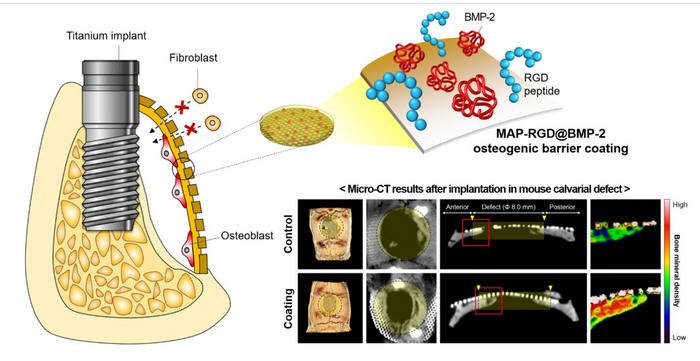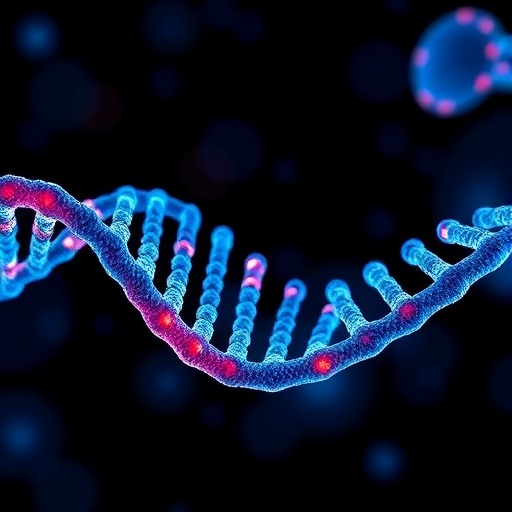One of the key factors of success in a dental implant is the condition of the periodontium around the implant. A higher long-term success rate of dental implants requires sufficient and healthy alveolar bone. In those cases where lack of alveolar bone renders setting an implant difficult, the bone should be regenerated sufficiently to receive the implant, whether before or during the implant surgery. Development of osteogenic barrier coating material for implants by a Korean research team is expected to improve the success rate of alveolar bone grafting.

Credit: POSTECH
One of the key factors of success in a dental implant is the condition of the periodontium around the implant. A higher long-term success rate of dental implants requires sufficient and healthy alveolar bone. In those cases where lack of alveolar bone renders setting an implant difficult, the bone should be regenerated sufficiently to receive the implant, whether before or during the implant surgery. Development of osteogenic barrier coating material for implants by a Korean research team is expected to improve the success rate of alveolar bone grafting.
Three research teams led by Professor Hyung Joon Cha of the Chemical Engineering Department at Pohang University of Science and Technology (POSTECH), Professor Yun Kee Jo of the School of Convergence at Kyungpook National University (KNU), and Professor Sang Ho Jun of the Department of Oral and Maxillofacial Surgery at Korea University Anam Hospital together developed an osteogenic barrier coating material for dental implants that prevents the invasion of soft tissue cells, attracts osteo-progenitor cells including bone stem cells, and sustainably releases the loaded bone morphogenetic protein-2 (BMP-2), significantly facilitating bone regeneration.
GBR is widely used in dental implant placement. It maintains the space for bones to grow and prevents cells other than osteogenic cells, such as fibroblasts, from populating the bone defect sites, allowing the bone to grow without interference by non-osteogenic cells. However, the GBR approach is still less likely to be successful and requires longer treatment time for those patients with insufficient bone quantity and quality. Depending on the configurations of defect sites, preventing the invasion of the non-osteogenic cells by using barrier membranes alone is not enough to significantly facilitate the bone regeneration.
The joint research team first loaded BMP-2 on top of the bioengineered material where RGD peptide, cell recognitive motif that is capable of attracting cells, is fused with mussel adhesive protein (MAP) that maintains strong adhesiveness in a wet environment. The team then coated the titanium mesh (Ti-mesh) membrane with it. According to the research findings, the coated barrier membrane exhibited cell occlusivity where fibroblasts could not permeate the membrane. The team also found that it induced a high level of bone differentiation in a short period of time inside the membrane by means of high growth of mesenchymal stem cells and release of BMP-2.
Application of the developed MAP-based barrier coating for guided bone regeneration to a titanium membrane in a rat calvarial defect model showed that the coating roughly doubled the speed of bone tissue regeneration.
Professor Hyung Joon Cha who led the research said, “This research was conducted based on long-term research cooperation of the joint research team in the area of bone regeneration for implant placement. Its findings revealed the possibility of improving the success rate of implant treatment regardless of the bone condition.” He added that the research findings could also be applied to regenerate a variety of hard tissues.
The research findings were published in the online edition of the Bioengineering & Translational Medicine, a distinguished journal in the field of bioengineering and regenerative medicine. The study was conducted as a part of the Dentistry Technology R&D Project under the Korea Health Technology R&D Project funded by the Ministry of Health & Welfare, the High Value-added Food Technology Development Program funded by the Ministry of Agriculture, Food & Rural Affairs, and the BK21 Four Program by the National Research Foundation of Korea.
Journal
Bioengineering & Translational Medicine
DOI
10.1002/btm2.10493
Article Title
Cell recognitive bioadhesive-based osteogenic barrier coating with localized delivery of bone morphogenetic protein-2 for accelerated guided bone regeneration
Article Publication Date
18-Jan-2023




